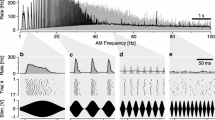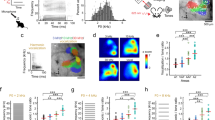Abstract
In crickets, auditory information about ultrasound is carried bilaterally to the brain by the AN2 neurons. The ON1 neuron provides contralateral inhibitory input to AN2, thereby enhancing bilateral contrast between the left and right AN2s, an important cue for sound localization. We examine how the structures of the spike trains of these neurons affect this inhibitory interaction. As previously shown for AN2, ON1 responds to salient peaks in stimulus amplitude with bursts of spikes. Spike bursts, but not isolated spikes, reliably signal the occurrence of specific features of the stimulus. ON1 and AN2 burst at similar times relative to the amplitude envelope of the stimulus, and bursts are more tightly time-locked to stimulus feature than the isolated spikes. As a consequence, spikes that, in the absence of contralateral inhibition, would occur within AN2 bursts are more likely to be preceded by spikes in ON1 (mainly also in bursts) than are isolated AN2 spikes. This leads to a large decrease in the burst rate of the inhibited AN2. We conclude that the match in coding properties of ON1 and AN2 allows contralateral inhibition to be most efficient for those portions of the response that carry the behaviourally relevant information, i.e. for bursts.






Similar content being viewed by others
References
Alitto HJ, Weyand TG, Martin Ursey W (2005) Distinct properties of stimulus-evoked bursts in the lateral geniculate nucleus. J Neurosci 25:514–523
Brand A, Behrend O, Marquardt T, McAlpine D, Grothe B (2002) Precise inhibition is essential for microsecond interaural time difference coding. Nature 417:543–547
Carr CE (1993) Processing of temporal information in the brain. Annu Rev Neurosci 16:223–243
Faulkes Z, Pollack GS (2000) Effects of inhibitory timing on contrast enhancement in auditory circuits in crickets (Teleogryllus oceanicus). J Neurophysiol 84:1247–1255
Grothe B (2003) New roles for synaptic inhibition in sound localization. Nat Rev Neurosci 4:540–550
Guido W, Lu SM, Vaughan JW, Godwin DW, Sherman SM (1995) Receiver operating characteristic (ROC) analysis of neurons in the cat’s lateral geniculate nucleus during tonic and burst response mode. Vis Neurosci 12:723–741
Horseman G, Huber F (1994) Sound localization in crickets. II. Modelling the role of a simple neural network in the prothoracic ganglion. J Comp Physiol A 175:399–413
Hoy RR, Nolen T, Brodfuehrer P (1989) The neuroethology of acoustic startle and escape in flying insects. J Exp Biol 146:287–306
Irvine DRF, Park VN, McCormick L (2001) Mechanisms underlying the sensitivity of neurons in the lateral superior olive to interaural intensity differences. J Neurophysiol 86:2647–2666
Joris PX, Smith PH, Yin TCT (1998) Coincidence detection in the auditory system: 50 years after Jeffress. Neuron 21:1235–1238
Krahe R, Gabbiani F (2004) Burst firing in sensory systems. Nat Rev Neurosci 5:13–23
Lesica NA, Stanley GB (2004) Encoding of natural scene movies by tonic and burst spikes in the lateral geniculate nucleus. J Neurosci 24:10731–10740
Lisman JE (1997) Bursts as a unit of neural information: making unreliable synapse reliable. Trends Neurosci 20:38–43
Marsat G, Pollack GS (2005) Effect of the temporal pattern of contralateral inhibition on sound localization cues. J Neurosci 25:6137–6144
Marsat G, Pollack GS (2006) A behavioral role for feature detection by sensory bursts. J Neurosci 26:10542–10547
Metzner W, Koch C, Wessel R, Gabbiani F (1998) Feature extraction by burst-like spike patterns in multiple sensory maps. J Neurosci 18:2283–2300
Michelsen A, Löhe G (1995) Tuned directionality in cricket ears. Nature 375:639
Middlebrooks JC, Green DM (1991) Sound localization by human listeners. Annu Rev Psychol 42:135–159
Nolen TG, Hoy RR (1984) Initiation of behavior by single neurons: the role of behavioral context. Science 226:992–994
Oertel D (1999) The role of timing in the brain stem auditory nuclei of vertebrates. Annu Rev Physiol 61:497–519
Oswald JP, Klug A, Park TJ (1999) Interaural intensity difference processing in auditory midbrain neurons: effects of a transient early inhibitory input. J Neurosci 19:1149–1163
Oswald AM, Chacron MJ, Doiron B, Bastian J, Maler L (2004) Parallel processing of sensory input by bursts and isolated spikes. J Neurosci 24:4351–4362
Park TJ, Grothe B, Pollak GD, Schuller G, Koch U (1996) Neural delays shape selectivity to interaural intensity differences in the lateral superior olive. J Neurosci 16:6554–6566
Pollack GS (1998) Neural processing of acoustic signals. In: Hoy RR, Popper AN, Fay RR (eds) Comparative hearing: insects. Springer, New-York, pp 139–196
Rayleigh Lord (1876) On our perception of the direction of a sound source. Nature 14:32–33
Selverston AI, Kleindienst HU, Hubert F (1985) Synaptic connectivity between cricket auditory interneurons as studied by photoinactivation. J Neurosci 5:1283–1292
Strausfeld NJ, Seyan HS, Wholers D, Bacon JP (1983) Lucifer yellow histology. In: Strausfeld NJ (ed) Functional neuroanatomy. Springer, Berlin, pp 132–155
Zar JH (1999) Biostatistical analysis. Prentice-Hall, Upper Saddle River
Acknowledgment
Supported by the Canadian Institutes for Health Research and the Natural Science and Engineering Research Council of Canada. We thank Dr. Jan Benda for his suggestions on this manuscript.
Author information
Authors and Affiliations
Corresponding author
Electronic supplementary material
Fig7
Supplemental figure 1: ON1 accounts for all measurable contralateral inhibition. The experimental configuration was similar to that described in the methods: dichotic stimulation and dual recordings of ON1 and AN2, except that ON1 was recorded intracellularly, permitting it to be silenced by hyperpolarizing current injection. This experiment replicates that of Faulkes and Pollack (2000) except that we used ultrasound stimuli. Data points are average spike counts for 10-20 repetition of each stimulus (representative SD are shown). There is no significant difference between the response of AN2 to monaural stimulation and that to binaural stimulation with ON1 hyperpolarized (ANOVA, p= 0.25); thus demonstrating that ON1 accounts for all contralateral inhibition.
Rights and permissions
About this article
Cite this article
Marsat, G., Pollack, G.S. Efficient inhibition of bursts by bursts in the auditory system of crickets. J Comp Physiol A 193, 625–633 (2007). https://doi.org/10.1007/s00359-007-0217-y
Received:
Revised:
Accepted:
Published:
Issue Date:
DOI: https://doi.org/10.1007/s00359-007-0217-y




